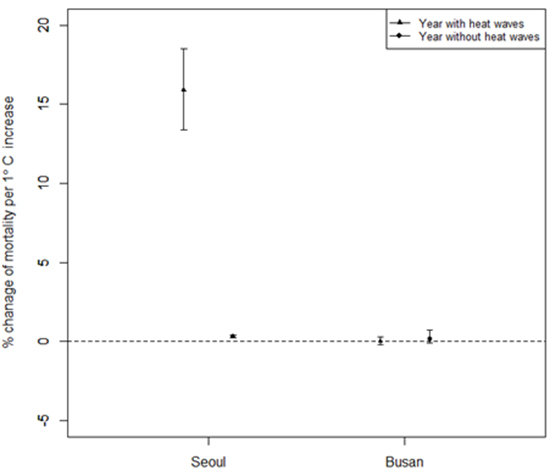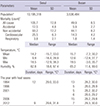2. Basu R, Feng WY, Ostro BD. Characterizing temperature and mortality in nine California counties. Epidemiology. 2008; 19:138–145.
3. Anderson BG, Bell ML. Weather-related mortality: how heat, cold, and heat waves affect mortality in the United States. Epidemiology. 2009; 20:205–213.
4. Hajat S, Kosatky T. Heat-related mortality: a review and exploration of heterogeneity. J Epidemiol Community Health. 2010; 64:753–760.
5. Barnett AG. Temperature and cardiovascular deaths in the US elderly: changes over time. Epidemiology. 2007; 18:369–372.
6. Davis RE, Knappenberger PC, Novicoff WM, Michaels PJ. Decadal changes in summer mortality in U.S. cities. Int J Biometeorol. 2003; 47:166–175.
7. Guo Y, Barnett AG, Tong S. High temperatures-related elderly mortality varied greatly from year to year: important information for heat-warning systems. Sci Rep. 2012; 2:830.
8. Hajat S, Armstrong B, Baccini M, Biggeri A, Bisanti L, Russo A, Paldy A, Menne B, Kosatsky T. Impact of high temperatures on mortality: is there an added heat wave effect? Epidemiology. 2006; 17:632–638.
9. Anderson GB, Bell ML. Heat waves in the United States: mortality risk during heat waves and effect modification by heat wave characteristics in 43 U.S. communities. Environ Health Perspect. 2011; 119:210–218.
10. Bobb JF, Peng RD, Bell ML, Dominici F. Heat-related mortality and adaptation to heat in the United States. Environ Health Perspect. 2014; 122:811–816.
11. Meehl GA, Tebaldi C. More intense, more frequent, and longer lasting heat waves in the 21st century. Science. 2004; 305:994–997.
12. Li T, Horton RM, Kinney P. Future projections of seasonal patterns in temperature-related deaths for Manhattan. Nat Clim Chang. 2013; 3:717–721.
15. Frich P, Alexander LV, Della-Marta P, Gleason B, Haylock M, Klein Tank AM, Peterson T. Observed coherent changes in climatic extremes during the second half of the twentieth century. Clim Res. 2002; 19:193–212.
17. Carson C, Hajat S, Armstrong B, Wilkinson P. Declining vulnerability to temperature-related mortality in London over the 20th century. Am J Epidemiol. 2006; 164:77–84.
18. Petkova EP, Gasparrini A, Kinney PL. Heat and mortality in New York City since the beginning of the 20th century. Epidemiology. 2014; 25:554–560.
19. Lim YH, Kim H, Hong YC. Variation in mortality of ischemic and hemorrhagic strokes in relation to high temperature. Int J Biometeorol. 2013; 57:145–153.
20. Lee S, Kim H, Yi SM. The relationships between temperature changes and mortality in Seoul, Korea. J Environ Health Sci. 2010; 36:20–26.
21. Rocklov J, Barnett AG, Woodward A. On the estimation of heat-intensity and heat-duration effects in time series models of temperature-related mortality in Stockholm, Sweden. Environ Health. 2012; 11:23.
22. Martin SL, Cakmak S, Hebbern CA, Avramescu ML, Tremblay N. Climate change and future temperature-related mortality in 15 Canadian cities. Int J Biometeorol. 2012; 56:605–619.
23. Medina-Ramón M, Schwartz J. Temperature, temperature extremes, and mortality: a study of acclimatisation and effect modification in 50 US cities. Occup Environ Med. 2007; 64:827–833.
24. Curriero FC, Heiner KS, Samet JM, Zeger SL, Strug L, Patz JA. Temperature and mortality in 11 cities of the eastern United States. Am J Epidemiol. 2002; 155:80–87.
25. Xiao J, Peng J, Zhang Y, Liu T, Rutherford S, Lin H, Qian Z, Huang C, Luo Y, Zeng W, et al. How much does latitude modify temperature-mortality relationship in 13 eastern US cities? Int J Biometeorol. 2015; 59:365–372.
27. Goggins WB, Chan EY, Ng E, Ren C, Chen L. Effect modification of the association between short-term meteorological factors and mortality by urban heat islands in Hong Kong. PLoS One. 2012; 7:e38551.
28. Gabriel KM, Endlicher WR. Urban and rural mortality rates during heat waves in Berlin and Brandenburg, Germany. Environ Pollut. 2011; 159:2044–2050.
29. Vandentorren S, Bretin P, Zeghnoun A, Mandereau-Bruno L, Croisier A, Cochet C, Ribéron J, Siberan I, Declercq B, Ledrans M. August 2003 heat wave in France: risk factors for death of elderly people living at home. Eur J Public Health. 2006; 16:583–591.
30. Smargiassi A, Goldberg MS, Plante C, Fournier M, Baudouin Y, Kosatsky T. Variation of daily warm season mortality as a function of micro-urban heat islands. J Epidemiol Community Health. 2009; 63:659–664.
31. Kim YH, Baik JJ. Daily maximum urban heat island intensity in large cities of Korea. Theor Appl Climatol. 2004; 79:151–164.
32. Chung JY, Honda Y, Hong YC, Pan XC, Guo YL, Kim H. Ambient temperature and mortality: an international study in four capital cities of East Asia. Sci Total Environ. 2009; 408:390–396.








